HRM Assignment: Evaluating Motivation Theories and Employee Records
VerifiedAdded on 2022/09/09
|10
|2327
|23
Report
AI Summary
This report delves into the crucial relationship between employee motivation and reward strategies within small to medium-sized organizations. It begins by evaluating two prominent motivation theories: Maslow's hierarchy of needs and Herzberg's two-factor theory, highlighting their practical applications in shaping effective reward systems. The report then explores the significance of maintaining comprehensive employee records, emphasizing their role in fostering positive employee-employer relationships, tracking performance, and ensuring compliance. Furthermore, it provides examples of employee record systems, including the use of HRIS and other tools, to streamline data management and enhance organizational efficiency. The analysis underscores the interconnectedness of motivation, reward, and record-keeping in driving employee performance and overall organizational success.
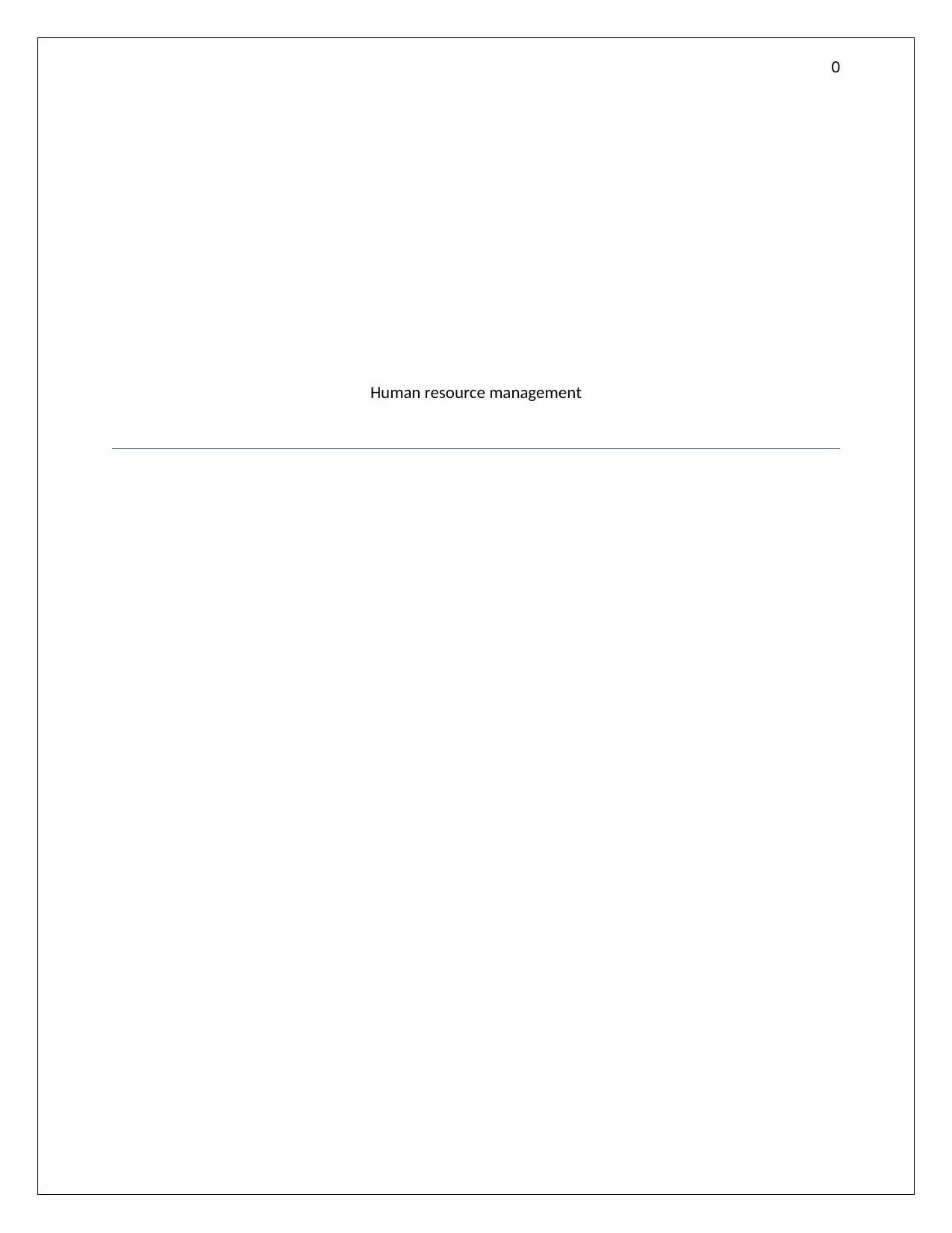
0
Human resource management
Human resource management
Paraphrase This Document
Need a fresh take? Get an instant paraphrase of this document with our AI Paraphraser
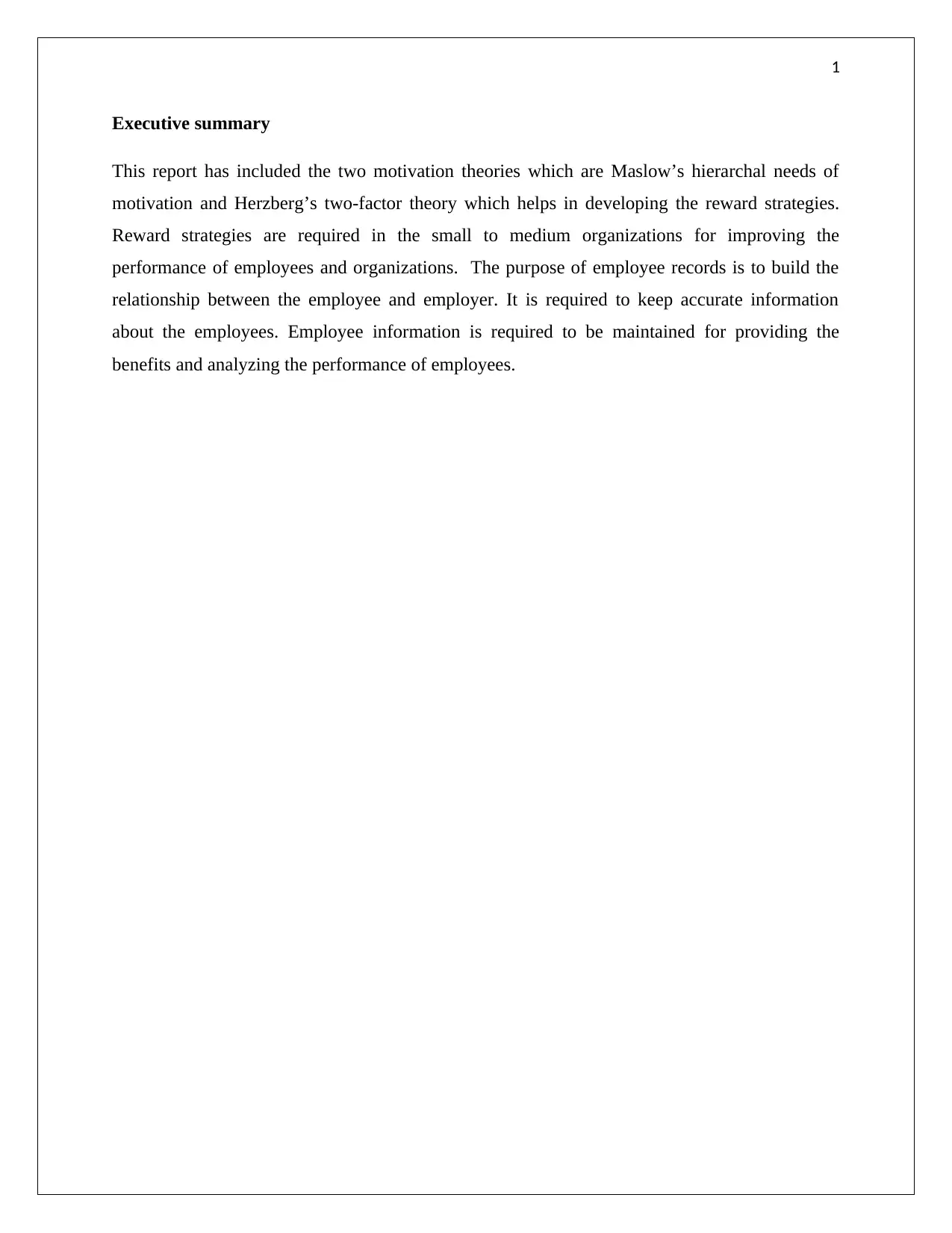
1
Executive summary
This report has included the two motivation theories which are Maslow’s hierarchal needs of
motivation and Herzberg’s two-factor theory which helps in developing the reward strategies.
Reward strategies are required in the small to medium organizations for improving the
performance of employees and organizations. The purpose of employee records is to build the
relationship between the employee and employer. It is required to keep accurate information
about the employees. Employee information is required to be maintained for providing the
benefits and analyzing the performance of employees.
Executive summary
This report has included the two motivation theories which are Maslow’s hierarchal needs of
motivation and Herzberg’s two-factor theory which helps in developing the reward strategies.
Reward strategies are required in the small to medium organizations for improving the
performance of employees and organizations. The purpose of employee records is to build the
relationship between the employee and employer. It is required to keep accurate information
about the employees. Employee information is required to be maintained for providing the
benefits and analyzing the performance of employees.
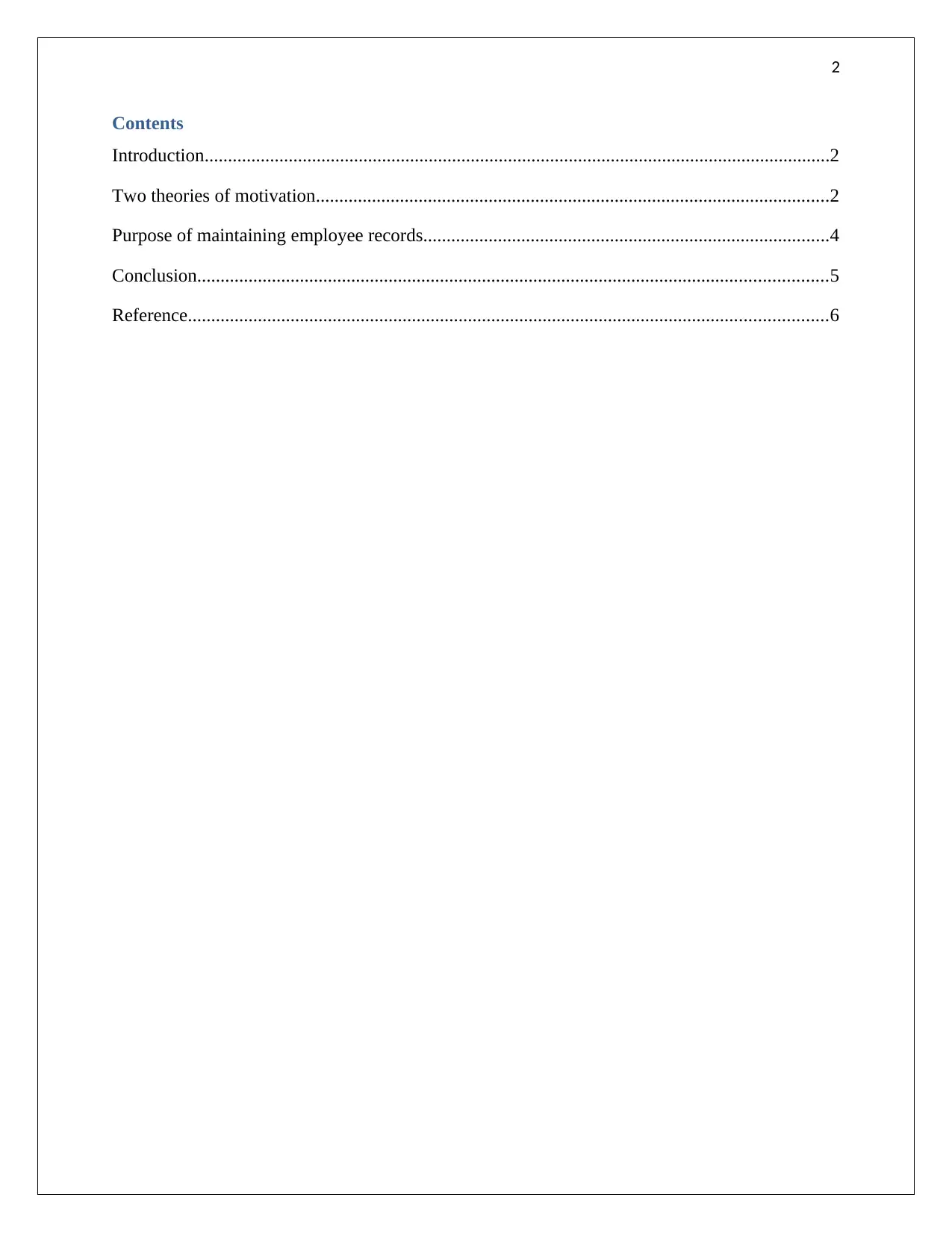
2
Contents
Introduction......................................................................................................................................2
Two theories of motivation..............................................................................................................2
Purpose of maintaining employee records.......................................................................................4
Conclusion.......................................................................................................................................5
Reference.........................................................................................................................................6
Contents
Introduction......................................................................................................................................2
Two theories of motivation..............................................................................................................2
Purpose of maintaining employee records.......................................................................................4
Conclusion.......................................................................................................................................5
Reference.........................................................................................................................................6
⊘ This is a preview!⊘
Do you want full access?
Subscribe today to unlock all pages.

Trusted by 1+ million students worldwide
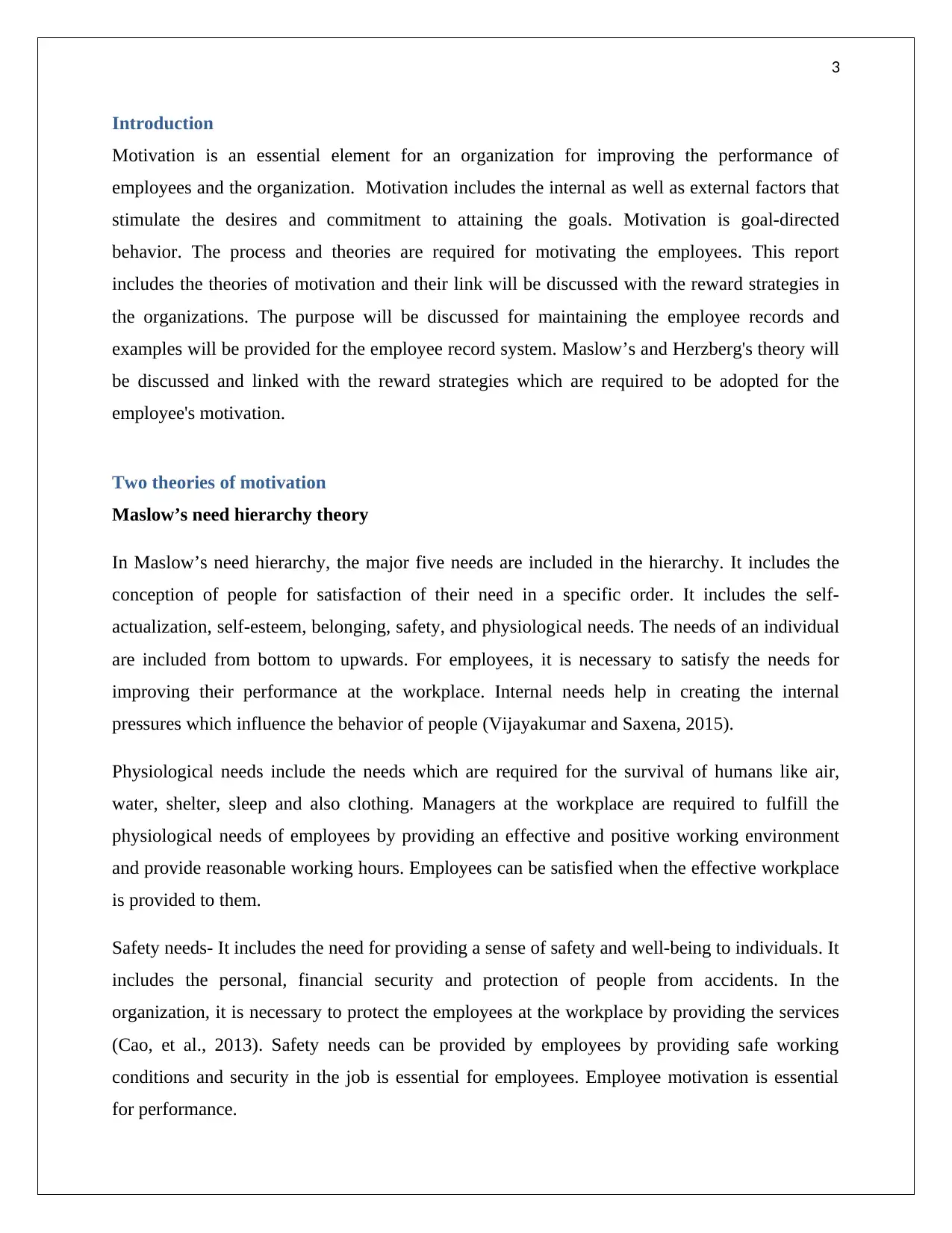
3
Introduction
Motivation is an essential element for an organization for improving the performance of
employees and the organization. Motivation includes the internal as well as external factors that
stimulate the desires and commitment to attaining the goals. Motivation is goal-directed
behavior. The process and theories are required for motivating the employees. This report
includes the theories of motivation and their link will be discussed with the reward strategies in
the organizations. The purpose will be discussed for maintaining the employee records and
examples will be provided for the employee record system. Maslow’s and Herzberg's theory will
be discussed and linked with the reward strategies which are required to be adopted for the
employee's motivation.
Two theories of motivation
Maslow’s need hierarchy theory
In Maslow’s need hierarchy, the major five needs are included in the hierarchy. It includes the
conception of people for satisfaction of their need in a specific order. It includes the self-
actualization, self-esteem, belonging, safety, and physiological needs. The needs of an individual
are included from bottom to upwards. For employees, it is necessary to satisfy the needs for
improving their performance at the workplace. Internal needs help in creating the internal
pressures which influence the behavior of people (Vijayakumar and Saxena, 2015).
Physiological needs include the needs which are required for the survival of humans like air,
water, shelter, sleep and also clothing. Managers at the workplace are required to fulfill the
physiological needs of employees by providing an effective and positive working environment
and provide reasonable working hours. Employees can be satisfied when the effective workplace
is provided to them.
Safety needs- It includes the need for providing a sense of safety and well-being to individuals. It
includes the personal, financial security and protection of people from accidents. In the
organization, it is necessary to protect the employees at the workplace by providing the services
(Cao, et al., 2013). Safety needs can be provided by employees by providing safe working
conditions and security in the job is essential for employees. Employee motivation is essential
for performance.
Introduction
Motivation is an essential element for an organization for improving the performance of
employees and the organization. Motivation includes the internal as well as external factors that
stimulate the desires and commitment to attaining the goals. Motivation is goal-directed
behavior. The process and theories are required for motivating the employees. This report
includes the theories of motivation and their link will be discussed with the reward strategies in
the organizations. The purpose will be discussed for maintaining the employee records and
examples will be provided for the employee record system. Maslow’s and Herzberg's theory will
be discussed and linked with the reward strategies which are required to be adopted for the
employee's motivation.
Two theories of motivation
Maslow’s need hierarchy theory
In Maslow’s need hierarchy, the major five needs are included in the hierarchy. It includes the
conception of people for satisfaction of their need in a specific order. It includes the self-
actualization, self-esteem, belonging, safety, and physiological needs. The needs of an individual
are included from bottom to upwards. For employees, it is necessary to satisfy the needs for
improving their performance at the workplace. Internal needs help in creating the internal
pressures which influence the behavior of people (Vijayakumar and Saxena, 2015).
Physiological needs include the needs which are required for the survival of humans like air,
water, shelter, sleep and also clothing. Managers at the workplace are required to fulfill the
physiological needs of employees by providing an effective and positive working environment
and provide reasonable working hours. Employees can be satisfied when the effective workplace
is provided to them.
Safety needs- It includes the need for providing a sense of safety and well-being to individuals. It
includes the personal, financial security and protection of people from accidents. In the
organization, it is necessary to protect the employees at the workplace by providing the services
(Cao, et al., 2013). Safety needs can be provided by employees by providing safe working
conditions and security in the job is essential for employees. Employee motivation is essential
for performance.
Paraphrase This Document
Need a fresh take? Get an instant paraphrase of this document with our AI Paraphraser
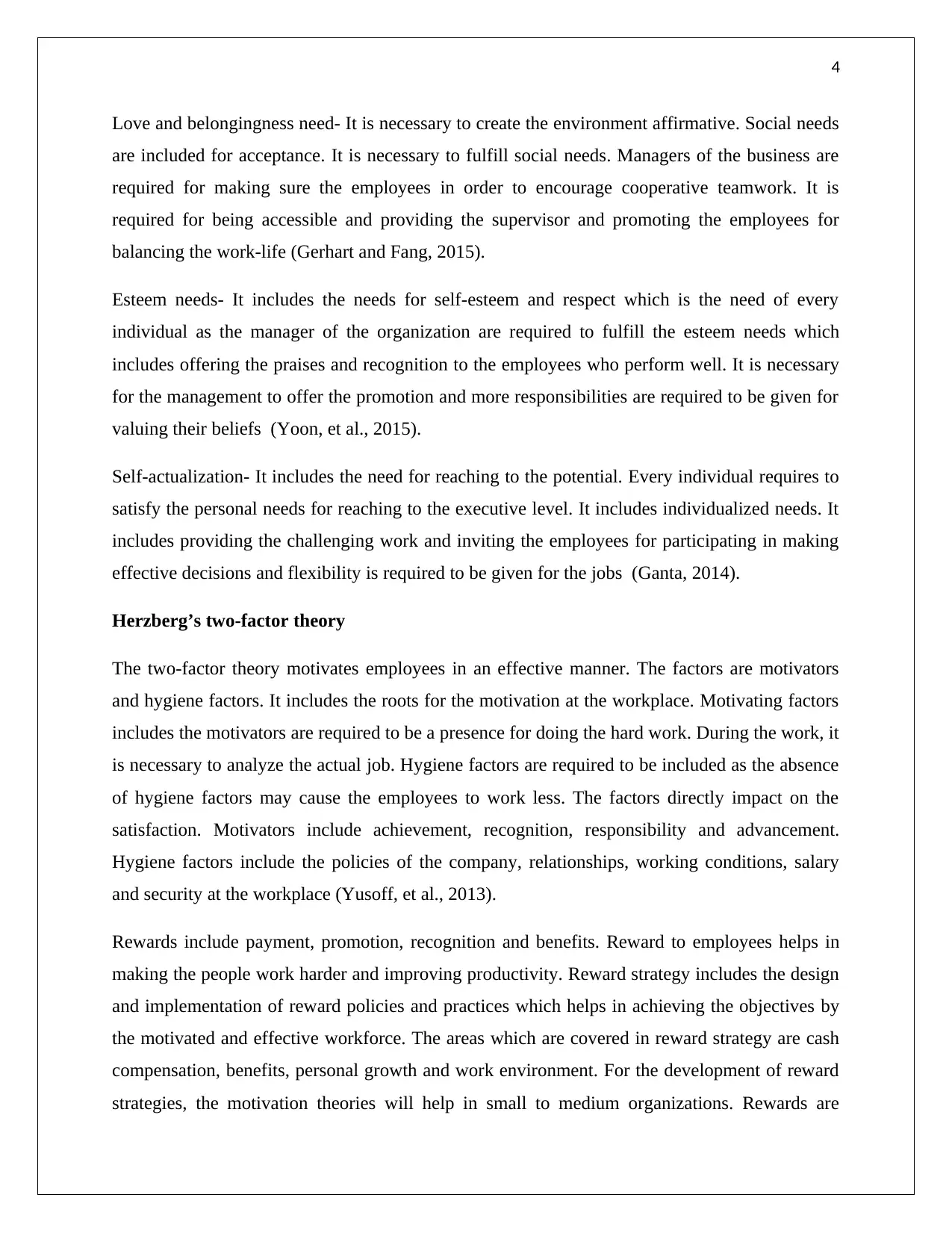
4
Love and belongingness need- It is necessary to create the environment affirmative. Social needs
are included for acceptance. It is necessary to fulfill social needs. Managers of the business are
required for making sure the employees in order to encourage cooperative teamwork. It is
required for being accessible and providing the supervisor and promoting the employees for
balancing the work-life (Gerhart and Fang, 2015).
Esteem needs- It includes the needs for self-esteem and respect which is the need of every
individual as the manager of the organization are required to fulfill the esteem needs which
includes offering the praises and recognition to the employees who perform well. It is necessary
for the management to offer the promotion and more responsibilities are required to be given for
valuing their beliefs (Yoon, et al., 2015).
Self-actualization- It includes the need for reaching to the potential. Every individual requires to
satisfy the personal needs for reaching to the executive level. It includes individualized needs. It
includes providing the challenging work and inviting the employees for participating in making
effective decisions and flexibility is required to be given for the jobs (Ganta, 2014).
Herzberg’s two-factor theory
The two-factor theory motivates employees in an effective manner. The factors are motivators
and hygiene factors. It includes the roots for the motivation at the workplace. Motivating factors
includes the motivators are required to be a presence for doing the hard work. During the work, it
is necessary to analyze the actual job. Hygiene factors are required to be included as the absence
of hygiene factors may cause the employees to work less. The factors directly impact on the
satisfaction. Motivators include achievement, recognition, responsibility and advancement.
Hygiene factors include the policies of the company, relationships, working conditions, salary
and security at the workplace (Yusoff, et al., 2013).
Rewards include payment, promotion, recognition and benefits. Reward to employees helps in
making the people work harder and improving productivity. Reward strategy includes the design
and implementation of reward policies and practices which helps in achieving the objectives by
the motivated and effective workforce. The areas which are covered in reward strategy are cash
compensation, benefits, personal growth and work environment. For the development of reward
strategies, the motivation theories will help in small to medium organizations. Rewards are
Love and belongingness need- It is necessary to create the environment affirmative. Social needs
are included for acceptance. It is necessary to fulfill social needs. Managers of the business are
required for making sure the employees in order to encourage cooperative teamwork. It is
required for being accessible and providing the supervisor and promoting the employees for
balancing the work-life (Gerhart and Fang, 2015).
Esteem needs- It includes the needs for self-esteem and respect which is the need of every
individual as the manager of the organization are required to fulfill the esteem needs which
includes offering the praises and recognition to the employees who perform well. It is necessary
for the management to offer the promotion and more responsibilities are required to be given for
valuing their beliefs (Yoon, et al., 2015).
Self-actualization- It includes the need for reaching to the potential. Every individual requires to
satisfy the personal needs for reaching to the executive level. It includes individualized needs. It
includes providing the challenging work and inviting the employees for participating in making
effective decisions and flexibility is required to be given for the jobs (Ganta, 2014).
Herzberg’s two-factor theory
The two-factor theory motivates employees in an effective manner. The factors are motivators
and hygiene factors. It includes the roots for the motivation at the workplace. Motivating factors
includes the motivators are required to be a presence for doing the hard work. During the work, it
is necessary to analyze the actual job. Hygiene factors are required to be included as the absence
of hygiene factors may cause the employees to work less. The factors directly impact on the
satisfaction. Motivators include achievement, recognition, responsibility and advancement.
Hygiene factors include the policies of the company, relationships, working conditions, salary
and security at the workplace (Yusoff, et al., 2013).
Rewards include payment, promotion, recognition and benefits. Reward to employees helps in
making the people work harder and improving productivity. Reward strategy includes the design
and implementation of reward policies and practices which helps in achieving the objectives by
the motivated and effective workforce. The areas which are covered in reward strategy are cash
compensation, benefits, personal growth and work environment. For the development of reward
strategies, the motivation theories will help in small to medium organizations. Rewards are
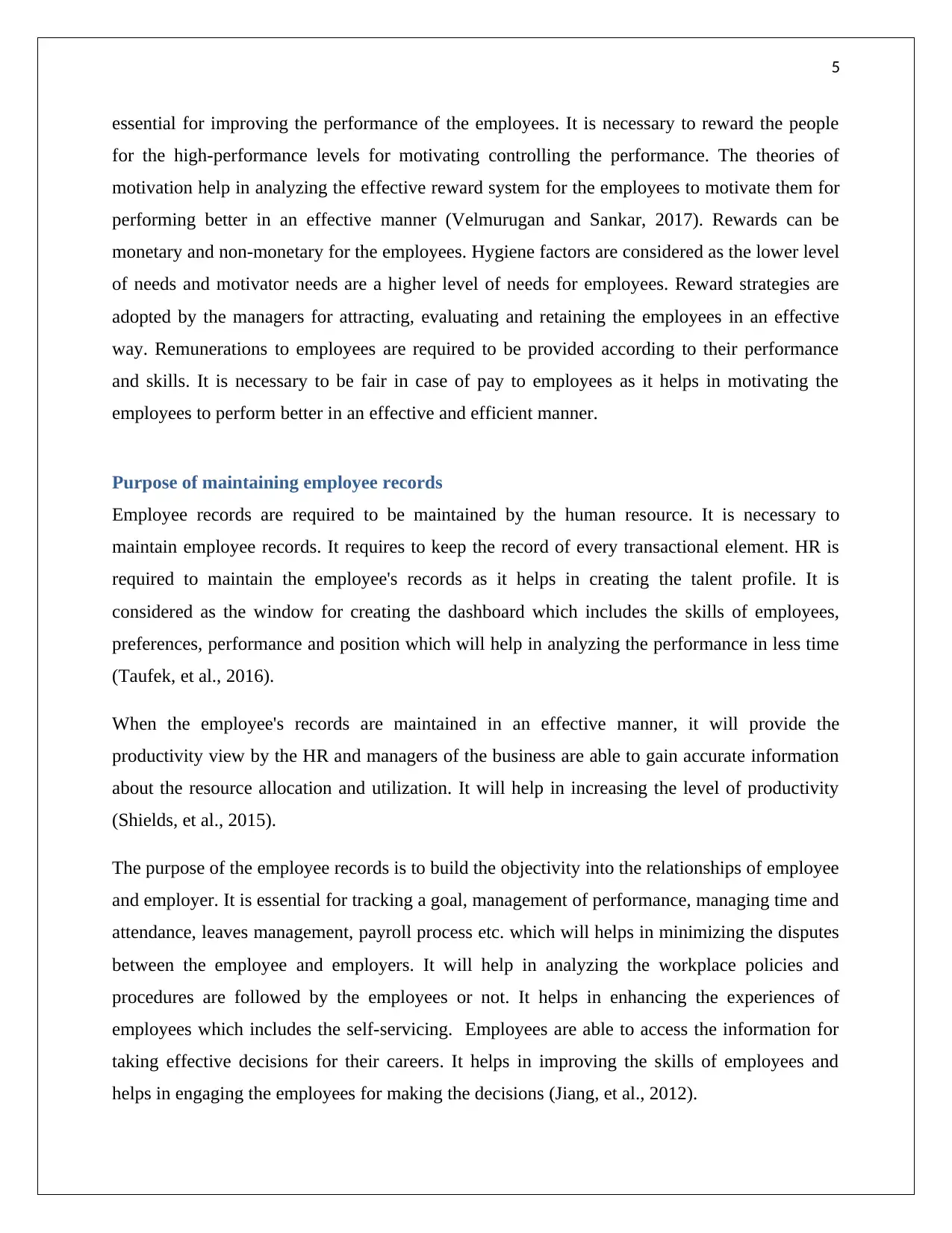
5
essential for improving the performance of the employees. It is necessary to reward the people
for the high-performance levels for motivating controlling the performance. The theories of
motivation help in analyzing the effective reward system for the employees to motivate them for
performing better in an effective manner (Velmurugan and Sankar, 2017). Rewards can be
monetary and non-monetary for the employees. Hygiene factors are considered as the lower level
of needs and motivator needs are a higher level of needs for employees. Reward strategies are
adopted by the managers for attracting, evaluating and retaining the employees in an effective
way. Remunerations to employees are required to be provided according to their performance
and skills. It is necessary to be fair in case of pay to employees as it helps in motivating the
employees to perform better in an effective and efficient manner.
Purpose of maintaining employee records
Employee records are required to be maintained by the human resource. It is necessary to
maintain employee records. It requires to keep the record of every transactional element. HR is
required to maintain the employee's records as it helps in creating the talent profile. It is
considered as the window for creating the dashboard which includes the skills of employees,
preferences, performance and position which will help in analyzing the performance in less time
(Taufek, et al., 2016).
When the employee's records are maintained in an effective manner, it will provide the
productivity view by the HR and managers of the business are able to gain accurate information
about the resource allocation and utilization. It will help in increasing the level of productivity
(Shields, et al., 2015).
The purpose of the employee records is to build the objectivity into the relationships of employee
and employer. It is essential for tracking a goal, management of performance, managing time and
attendance, leaves management, payroll process etc. which will helps in minimizing the disputes
between the employee and employers. It will help in analyzing the workplace policies and
procedures are followed by the employees or not. It helps in enhancing the experiences of
employees which includes the self-servicing. Employees are able to access the information for
taking effective decisions for their careers. It helps in improving the skills of employees and
helps in engaging the employees for making the decisions (Jiang, et al., 2012).
essential for improving the performance of the employees. It is necessary to reward the people
for the high-performance levels for motivating controlling the performance. The theories of
motivation help in analyzing the effective reward system for the employees to motivate them for
performing better in an effective manner (Velmurugan and Sankar, 2017). Rewards can be
monetary and non-monetary for the employees. Hygiene factors are considered as the lower level
of needs and motivator needs are a higher level of needs for employees. Reward strategies are
adopted by the managers for attracting, evaluating and retaining the employees in an effective
way. Remunerations to employees are required to be provided according to their performance
and skills. It is necessary to be fair in case of pay to employees as it helps in motivating the
employees to perform better in an effective and efficient manner.
Purpose of maintaining employee records
Employee records are required to be maintained by the human resource. It is necessary to
maintain employee records. It requires to keep the record of every transactional element. HR is
required to maintain the employee's records as it helps in creating the talent profile. It is
considered as the window for creating the dashboard which includes the skills of employees,
preferences, performance and position which will help in analyzing the performance in less time
(Taufek, et al., 2016).
When the employee's records are maintained in an effective manner, it will provide the
productivity view by the HR and managers of the business are able to gain accurate information
about the resource allocation and utilization. It will help in increasing the level of productivity
(Shields, et al., 2015).
The purpose of the employee records is to build the objectivity into the relationships of employee
and employer. It is essential for tracking a goal, management of performance, managing time and
attendance, leaves management, payroll process etc. which will helps in minimizing the disputes
between the employee and employers. It will help in analyzing the workplace policies and
procedures are followed by the employees or not. It helps in enhancing the experiences of
employees which includes the self-servicing. Employees are able to access the information for
taking effective decisions for their careers. It helps in improving the skills of employees and
helps in engaging the employees for making the decisions (Jiang, et al., 2012).
⊘ This is a preview!⊘
Do you want full access?
Subscribe today to unlock all pages.

Trusted by 1+ million students worldwide
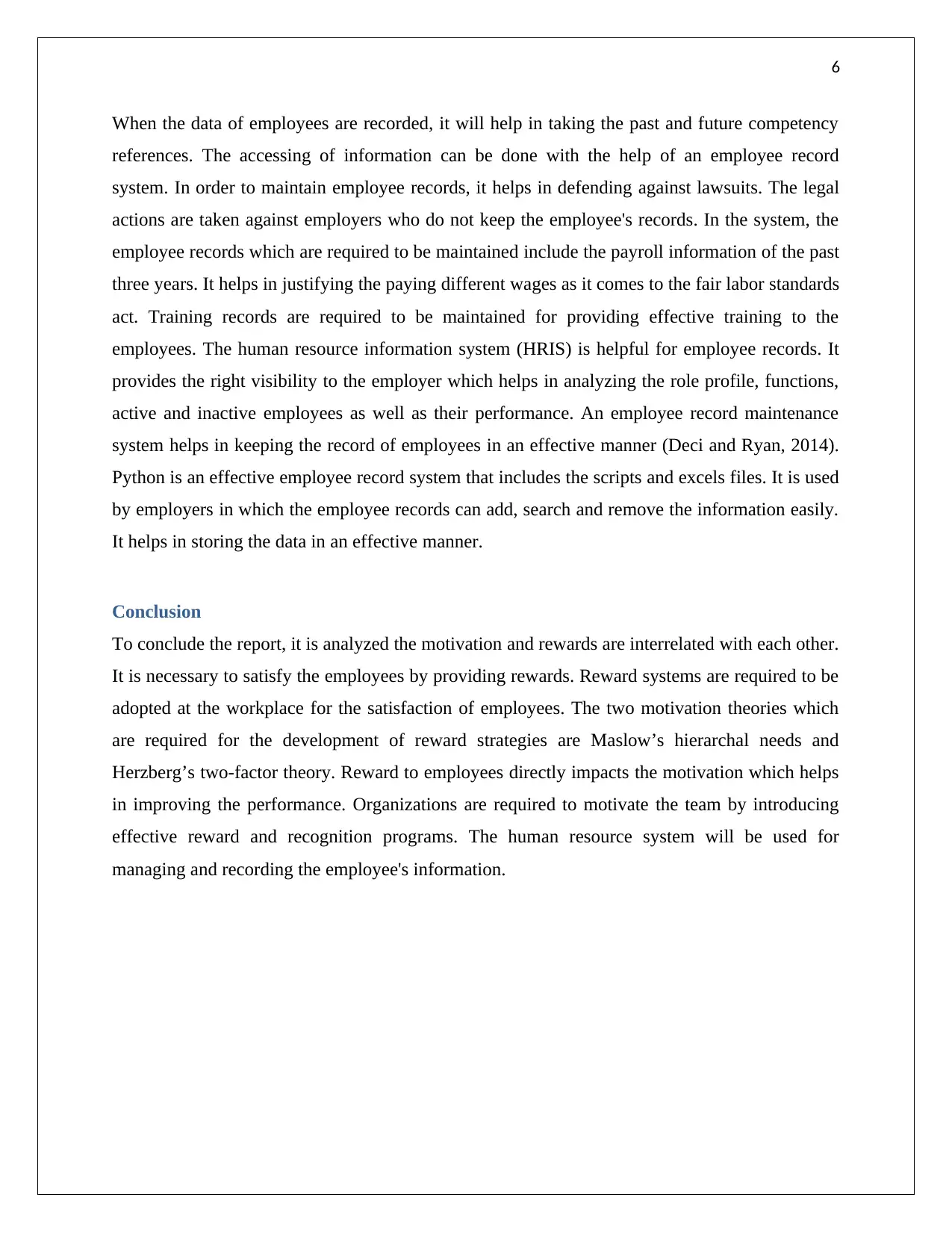
6
When the data of employees are recorded, it will help in taking the past and future competency
references. The accessing of information can be done with the help of an employee record
system. In order to maintain employee records, it helps in defending against lawsuits. The legal
actions are taken against employers who do not keep the employee's records. In the system, the
employee records which are required to be maintained include the payroll information of the past
three years. It helps in justifying the paying different wages as it comes to the fair labor standards
act. Training records are required to be maintained for providing effective training to the
employees. The human resource information system (HRIS) is helpful for employee records. It
provides the right visibility to the employer which helps in analyzing the role profile, functions,
active and inactive employees as well as their performance. An employee record maintenance
system helps in keeping the record of employees in an effective manner (Deci and Ryan, 2014).
Python is an effective employee record system that includes the scripts and excels files. It is used
by employers in which the employee records can add, search and remove the information easily.
It helps in storing the data in an effective manner.
Conclusion
To conclude the report, it is analyzed the motivation and rewards are interrelated with each other.
It is necessary to satisfy the employees by providing rewards. Reward systems are required to be
adopted at the workplace for the satisfaction of employees. The two motivation theories which
are required for the development of reward strategies are Maslow’s hierarchal needs and
Herzberg’s two-factor theory. Reward to employees directly impacts the motivation which helps
in improving the performance. Organizations are required to motivate the team by introducing
effective reward and recognition programs. The human resource system will be used for
managing and recording the employee's information.
When the data of employees are recorded, it will help in taking the past and future competency
references. The accessing of information can be done with the help of an employee record
system. In order to maintain employee records, it helps in defending against lawsuits. The legal
actions are taken against employers who do not keep the employee's records. In the system, the
employee records which are required to be maintained include the payroll information of the past
three years. It helps in justifying the paying different wages as it comes to the fair labor standards
act. Training records are required to be maintained for providing effective training to the
employees. The human resource information system (HRIS) is helpful for employee records. It
provides the right visibility to the employer which helps in analyzing the role profile, functions,
active and inactive employees as well as their performance. An employee record maintenance
system helps in keeping the record of employees in an effective manner (Deci and Ryan, 2014).
Python is an effective employee record system that includes the scripts and excels files. It is used
by employers in which the employee records can add, search and remove the information easily.
It helps in storing the data in an effective manner.
Conclusion
To conclude the report, it is analyzed the motivation and rewards are interrelated with each other.
It is necessary to satisfy the employees by providing rewards. Reward systems are required to be
adopted at the workplace for the satisfaction of employees. The two motivation theories which
are required for the development of reward strategies are Maslow’s hierarchal needs and
Herzberg’s two-factor theory. Reward to employees directly impacts the motivation which helps
in improving the performance. Organizations are required to motivate the team by introducing
effective reward and recognition programs. The human resource system will be used for
managing and recording the employee's information.
Paraphrase This Document
Need a fresh take? Get an instant paraphrase of this document with our AI Paraphraser
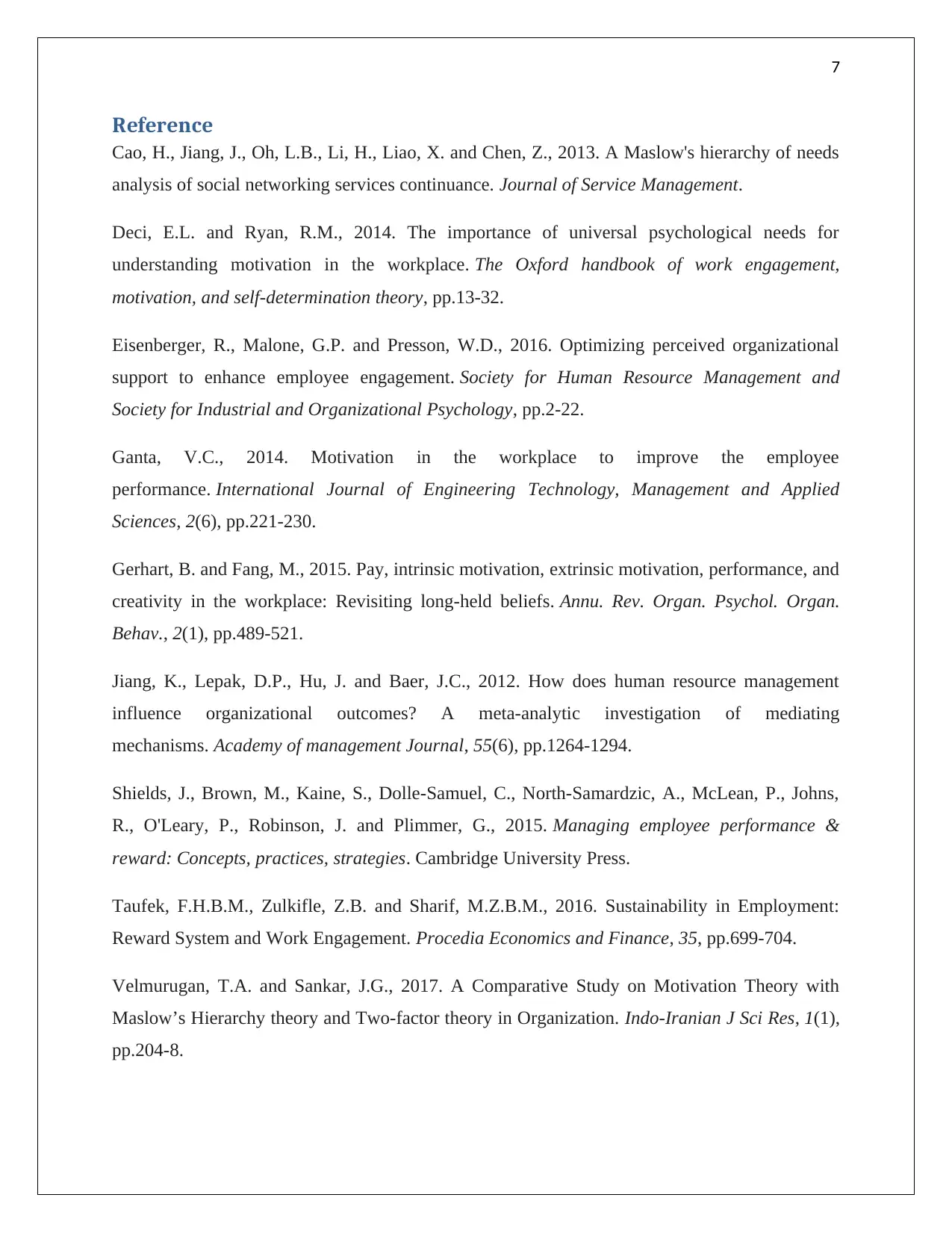
7
Reference
Cao, H., Jiang, J., Oh, L.B., Li, H., Liao, X. and Chen, Z., 2013. A Maslow's hierarchy of needs
analysis of social networking services continuance. Journal of Service Management.
Deci, E.L. and Ryan, R.M., 2014. The importance of universal psychological needs for
understanding motivation in the workplace. The Oxford handbook of work engagement,
motivation, and self-determination theory, pp.13-32.
Eisenberger, R., Malone, G.P. and Presson, W.D., 2016. Optimizing perceived organizational
support to enhance employee engagement. Society for Human Resource Management and
Society for Industrial and Organizational Psychology, pp.2-22.
Ganta, V.C., 2014. Motivation in the workplace to improve the employee
performance. International Journal of Engineering Technology, Management and Applied
Sciences, 2(6), pp.221-230.
Gerhart, B. and Fang, M., 2015. Pay, intrinsic motivation, extrinsic motivation, performance, and
creativity in the workplace: Revisiting long-held beliefs. Annu. Rev. Organ. Psychol. Organ.
Behav., 2(1), pp.489-521.
Jiang, K., Lepak, D.P., Hu, J. and Baer, J.C., 2012. How does human resource management
influence organizational outcomes? A meta-analytic investigation of mediating
mechanisms. Academy of management Journal, 55(6), pp.1264-1294.
Shields, J., Brown, M., Kaine, S., Dolle-Samuel, C., North-Samardzic, A., McLean, P., Johns,
R., O'Leary, P., Robinson, J. and Plimmer, G., 2015. Managing employee performance &
reward: Concepts, practices, strategies. Cambridge University Press.
Taufek, F.H.B.M., Zulkifle, Z.B. and Sharif, M.Z.B.M., 2016. Sustainability in Employment:
Reward System and Work Engagement. Procedia Economics and Finance, 35, pp.699-704.
Velmurugan, T.A. and Sankar, J.G., 2017. A Comparative Study on Motivation Theory with
Maslow’s Hierarchy theory and Two-factor theory in Organization. Indo-Iranian J Sci Res, 1(1),
pp.204-8.
Reference
Cao, H., Jiang, J., Oh, L.B., Li, H., Liao, X. and Chen, Z., 2013. A Maslow's hierarchy of needs
analysis of social networking services continuance. Journal of Service Management.
Deci, E.L. and Ryan, R.M., 2014. The importance of universal psychological needs for
understanding motivation in the workplace. The Oxford handbook of work engagement,
motivation, and self-determination theory, pp.13-32.
Eisenberger, R., Malone, G.P. and Presson, W.D., 2016. Optimizing perceived organizational
support to enhance employee engagement. Society for Human Resource Management and
Society for Industrial and Organizational Psychology, pp.2-22.
Ganta, V.C., 2014. Motivation in the workplace to improve the employee
performance. International Journal of Engineering Technology, Management and Applied
Sciences, 2(6), pp.221-230.
Gerhart, B. and Fang, M., 2015. Pay, intrinsic motivation, extrinsic motivation, performance, and
creativity in the workplace: Revisiting long-held beliefs. Annu. Rev. Organ. Psychol. Organ.
Behav., 2(1), pp.489-521.
Jiang, K., Lepak, D.P., Hu, J. and Baer, J.C., 2012. How does human resource management
influence organizational outcomes? A meta-analytic investigation of mediating
mechanisms. Academy of management Journal, 55(6), pp.1264-1294.
Shields, J., Brown, M., Kaine, S., Dolle-Samuel, C., North-Samardzic, A., McLean, P., Johns,
R., O'Leary, P., Robinson, J. and Plimmer, G., 2015. Managing employee performance &
reward: Concepts, practices, strategies. Cambridge University Press.
Taufek, F.H.B.M., Zulkifle, Z.B. and Sharif, M.Z.B.M., 2016. Sustainability in Employment:
Reward System and Work Engagement. Procedia Economics and Finance, 35, pp.699-704.
Velmurugan, T.A. and Sankar, J.G., 2017. A Comparative Study on Motivation Theory with
Maslow’s Hierarchy theory and Two-factor theory in Organization. Indo-Iranian J Sci Res, 1(1),
pp.204-8.
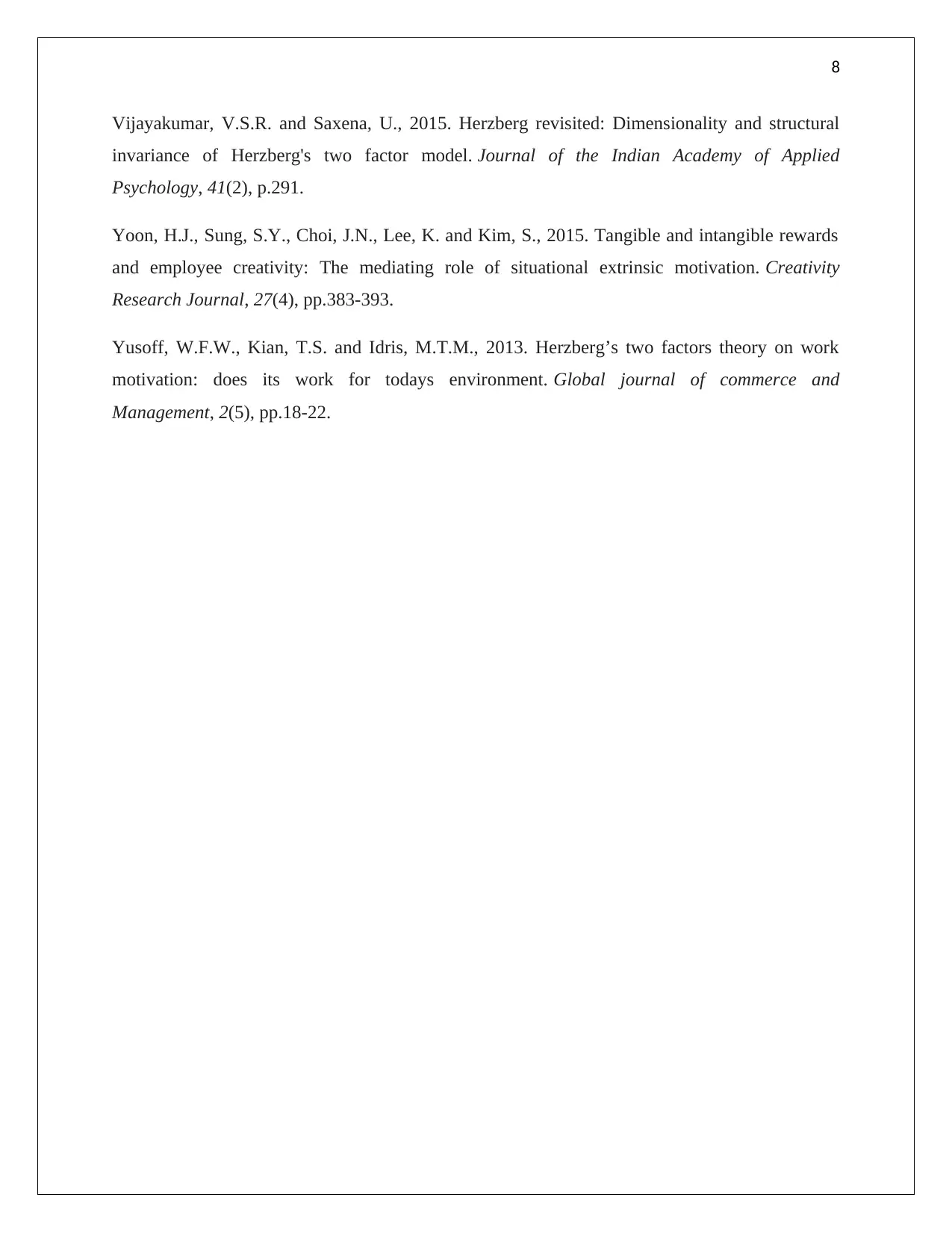
8
Vijayakumar, V.S.R. and Saxena, U., 2015. Herzberg revisited: Dimensionality and structural
invariance of Herzberg's two factor model. Journal of the Indian Academy of Applied
Psychology, 41(2), p.291.
Yoon, H.J., Sung, S.Y., Choi, J.N., Lee, K. and Kim, S., 2015. Tangible and intangible rewards
and employee creativity: The mediating role of situational extrinsic motivation. Creativity
Research Journal, 27(4), pp.383-393.
Yusoff, W.F.W., Kian, T.S. and Idris, M.T.M., 2013. Herzberg’s two factors theory on work
motivation: does its work for todays environment. Global journal of commerce and
Management, 2(5), pp.18-22.
Vijayakumar, V.S.R. and Saxena, U., 2015. Herzberg revisited: Dimensionality and structural
invariance of Herzberg's two factor model. Journal of the Indian Academy of Applied
Psychology, 41(2), p.291.
Yoon, H.J., Sung, S.Y., Choi, J.N., Lee, K. and Kim, S., 2015. Tangible and intangible rewards
and employee creativity: The mediating role of situational extrinsic motivation. Creativity
Research Journal, 27(4), pp.383-393.
Yusoff, W.F.W., Kian, T.S. and Idris, M.T.M., 2013. Herzberg’s two factors theory on work
motivation: does its work for todays environment. Global journal of commerce and
Management, 2(5), pp.18-22.
⊘ This is a preview!⊘
Do you want full access?
Subscribe today to unlock all pages.

Trusted by 1+ million students worldwide
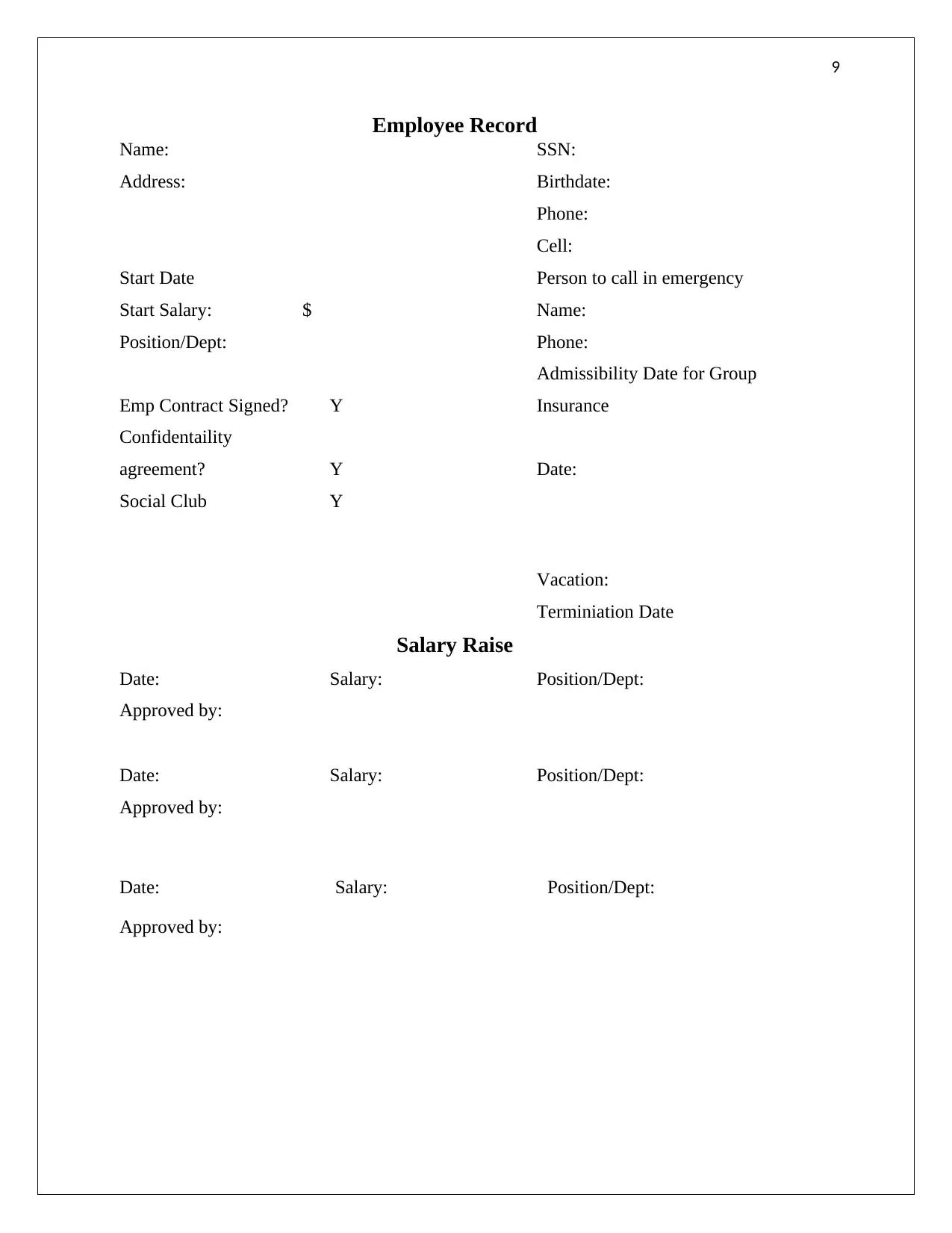
9
Employee Record
Name: SSN:
Address: Birthdate:
Phone:
Cell:
Start Date Person to call in emergency
Start Salary: $ Name:
Position/Dept: Phone:
Emp Contract Signed? Y
Admissibility Date for Group
Insurance
Confidentaility
agreement? Y Date:
Social Club Y
Vacation:
Terminiation Date
Salary Raise
Date: Salary: Position/Dept:
Approved by:
Date: Salary: Position/Dept:
Approved by:
Date: Salary: Position/Dept:
Approved by:
Employee Record
Name: SSN:
Address: Birthdate:
Phone:
Cell:
Start Date Person to call in emergency
Start Salary: $ Name:
Position/Dept: Phone:
Emp Contract Signed? Y
Admissibility Date for Group
Insurance
Confidentaility
agreement? Y Date:
Social Club Y
Vacation:
Terminiation Date
Salary Raise
Date: Salary: Position/Dept:
Approved by:
Date: Salary: Position/Dept:
Approved by:
Date: Salary: Position/Dept:
Approved by:
1 out of 10
Related Documents
Your All-in-One AI-Powered Toolkit for Academic Success.
+13062052269
info@desklib.com
Available 24*7 on WhatsApp / Email
![[object Object]](/_next/static/media/star-bottom.7253800d.svg)
Unlock your academic potential
Copyright © 2020–2025 A2Z Services. All Rights Reserved. Developed and managed by ZUCOL.





